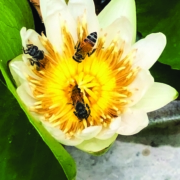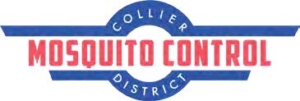The A-Bee-Cs of mosquito control by Patrick Linn, MS, MSHAPI Executive Director, Collier Mosquito Control District
 Many of you are asking about the effects of mosquito control treatments on our area’s bees and other pollinators. In this article, I hope to address those questions and provide reassurance that the Collier Mosquito Control District is committed to the health and well-being of the community we serve, including the beneficial insects who call Collier home.
Many of you are asking about the effects of mosquito control treatments on our area’s bees and other pollinators. In this article, I hope to address those questions and provide reassurance that the Collier Mosquito Control District is committed to the health and well-being of the community we serve, including the beneficial insects who call Collier home.
The success of any integrated mosquito management program requires application not only of control products, but of the knowledge and relationships between biology, ecology, and more. Great care is taken in planning the time of day we treat with materials that control adult mosquitoes. The District’s airplanes apply these materials when mosquitoes are most active: during twilight hours of dawn and dusk. That’s the time of day most pollinators are not active and therefore our materials will not come into contact with them.
The nighttime hours also tend to move humans indoors. The District seeks to pose an absolute minimum of risk to beneficial insects, humans, and pets. Thus, great care is taken in planning aerial treatments. An exception to aerial treatments occurs when the District applies granular materials via helicopter to swamp and mangrove areas during morning hours. These products are 100 percent mosquito larvae specific, and daylight is necessary to maintain safety of flight while applying the product.
 Extensive studies on the effect of nighttime Ultra Low Volume (ULV) adult mosquito control applications on non-target insects in the United States show no evidence of material risk to pollinator health. The combination of timing, altitude of application, droplet size, and product type all contribute to a mosquito-specific control effort. Further, the materials used by the District to control adult mosquitoes do not persist in the atmosphere or settle on surfaces. They degrade rapidly with time, sunlight, and the atmospheric changes associated with daytime hours.
Extensive studies on the effect of nighttime Ultra Low Volume (ULV) adult mosquito control applications on non-target insects in the United States show no evidence of material risk to pollinator health. The combination of timing, altitude of application, droplet size, and product type all contribute to a mosquito-specific control effort. Further, the materials used by the District to control adult mosquitoes do not persist in the atmosphere or settle on surfaces. They degrade rapidly with time, sunlight, and the atmospheric changes associated with daytime hours.
Many years ago, the District developed an automated notification system that alerts enrolled residents of mosquito control treatments when their home address is included in a treatment area. Our county’s apiarists eagerly adopted the use of the system, and those with concerns about their hives can verify that their bees are inside the hives at night when treatments occur in their area. You too can register to receive these alerts using the form on our website: www.cmcd.org/spray_maps/?notify If you wish to learn more about the extensive research into this topic, please visit www.mosquito.org/page/pollinators.
Want to know more about the science behind mosquito control? Looking for someone to speak to your group’s next meeting? Visit the District’s website at cmcd.org or call 239.436.1000.





Leave a Reply
Want to join the discussion?Feel free to contribute!